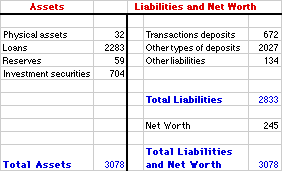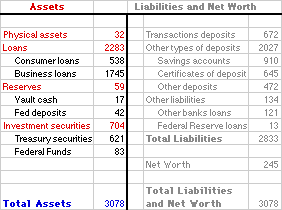
|
|
BIRTH RATE: The number of people born per 1,000 population. The birth rate is compared with the death rate to indicate the natural population growth of a country. (Net migration is also needed in the calculation of the final, overall, actual growth of population.) The birth rate most frequently comes up in economic development discussions of less developed countries and their progress (or lack thereof) through the demographic transition.
Visit the GLOSS*arama
|
|


|

|
                           BANK ASSETS: What a bank owns, including loans, reserves, investment securities, and physical assets. Bank assets are typically listed on the left-hand side of a bank's balance sheet. Bank liabilities, what a bank owes, are listed on the right-hand side of a bank's balance sheet. Net worth is the difference between assets and liabilities. The largest asset category of most bank is loans, which generates interest revenue. A critical asset category used to maintain the safety of deposits is reserves (vault cash and Federal Reserve deposits). Bank assets are the physical and financial "property" of a bank, what a bank owns. While a bank commonly owns physical property (buildings, land, furniture, equipment), the bulk of a bank's assets are financial--legal claims on the property or the wealth of others. The two most notable asset categories are loans (which generate interest revenue) and reserves (which keep deposits safe).A Representative, Hypothetical Balance Sheet| OmniBank Balance Sheet |  |
Before getting into the details of bank assets, consider this representative, hypothetical balance sheet for OmniBank (a representative, hypothetical bank) presented in the exhibit to the right. Like any balance sheet this one for the OmniBank is divided into two sides--assets on the left and liabilities and net worth on the right. As a "balance" sheet, both sides are equal--they balance. The assets on the left-hand side of the balance sheet are what OmniBank owns. Liabilities on the right-hand side of the balance sheet are what OmniBank owes. Net worth, also on the right-hand side of the balance sheet, is then the difference between assets and liabilities. In effect, net worth is what the bank owes to the owners of OmniBank. As a profit-seeking business, OmniBank's primary duty is to adjust these assets and liabilities to acquire profit. Of course, ALL businesses acquire profit by adjusting assets and liabilities. They boost revenue assets and reduce cost liabilities. But, unlike other types of producers, banks do not make adjustments with real production. In fact, the accounting process of adjusting entries in the balance sheet IS OmniBank's production. OmniBank's business is to change these entries. Four Assets| OmniBank Assets |  |
Now consider the primary asset categories for a bank. OmniBank assets are, of course, what the bank owns. OmniBank, being a representative bank, has four main categories of assets listed on the balance sheet at the right:- Physical Assets: This includes the buildings, land, furniture, and equipment owned by the bank. While this is what most people probably think of as assets, it is relatively minor for most banks.
- Loans: The second asset category, the most important one for all banks, is loans. Loans are the primary source of interest revenue. While a loan is a liability for the borrower, it is an asset for the bank, for the lender. This asset includes loans to consumers (home loans, personal loans, automobile loans, credit card loans) and businesses (real estate development loans, capital investment loans).
- Reserves: The third asset category is reserves. While this is small in amount, it is extremely important. Reserves are what banks use for daily transactions, such as processing checks or satisfying cash withdrawals. Banks use reserves to ensure the security of deposits. Two varieties of reserves worth noting are vault cash (the actual paper currency and coins that is kept in the bank, that is, in the vault) and Federal Reserve deposits (deposits that banks keep with the Federal Reserve System to clear checks and assist in other banking activities).
- Investment Securities: The fourth asset category is investment securities. These act as a buffer between loans and reserves. They are safer than loans, but not as safe as reserves. They pay more interest than reserves, but not as much as loans. If a bank has a few extra reserves, but is not ready to lock in loans for the long term, then investment securities are the answer. Two important items in this category are U.S. Treasury securities (the securities that the federal government issues to borrow the funds used to finance the federal deficit) and Federal funds (loans made to other banks).

Recommended Citation:BANK ASSETS, AmosWEB Encyclonomic WEB*pedia, http://www.AmosWEB.com, AmosWEB LLC, 2000-2025. [Accessed: July 2, 2025].
Check Out These Related Terms... | | | | | | | |
Or For A Little Background... | | | | | | | | | | |
And For Further Study... | | | | | | |
Related Websites (Will Open in New Window)... | | |
Search Again?
Back to the WEB*pedia
|



|

|
GRAY SKITTERY
[What's This?]
Today, you are likely to spend a great deal of time visiting every yard sale in a 30-mile radius wanting to buy either super soft, super cuddly, stuffed animals or a large stuffed brown and white teddy bear. Be on the lookout for door-to-door salesmen.
Your Complete Scope
This isn't me! What am I?
|

|
|
A thousand years before metal coins were developed, clay tablet "checks" were used as money by the Babylonians.
|

|
|
"always remember an epitaph which is in the cemetery at Tombstone, Arizona. It says: „Here lies Jack Williams. He done his damnedest.¾ I think that is the greatest epitaph a man can have ‚ When he gives everything that is in him to do the job he has before him. That is all you can ask of him and that is what I have tried to do. " -- Harry Truman, 33rd US president
|

|
LRMC
Long Run Marginal Cost
|

|
|
Tell us what you think about AmosWEB. Like what you see? Have suggestions for improvements? Let us know. Click the User Feedback link.
User Feedback
|


|


